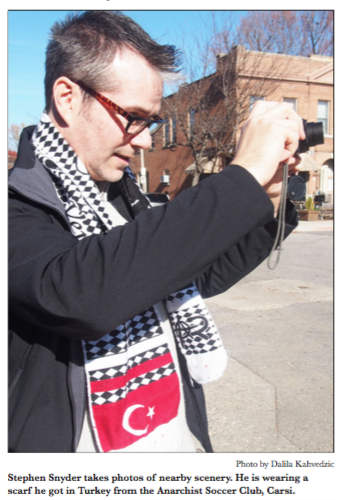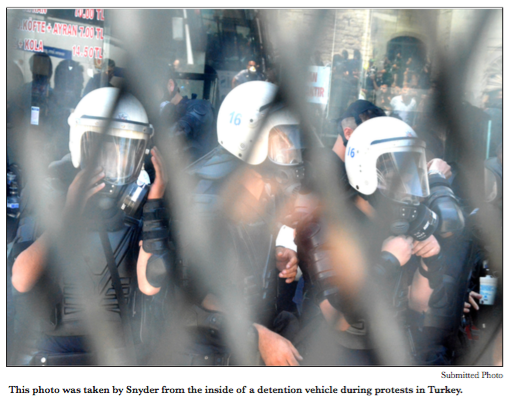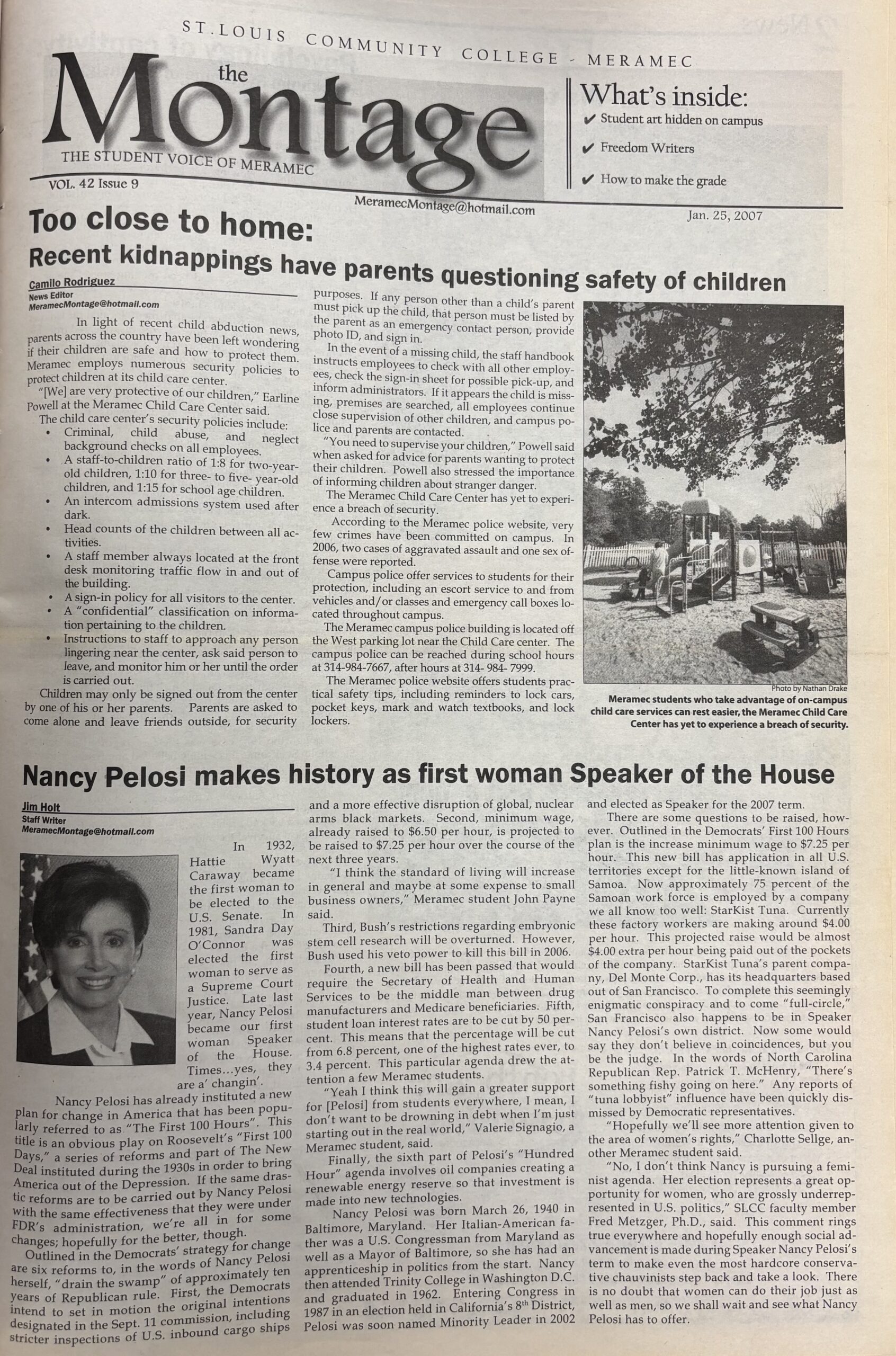Former STLCC-Meramec professor travels to Germany and Turkey to teach and study
By: DALILA KAHVEDZIC
Editor-In-Chief
Stephen Snyder took his philosophy and photography skills across the globe and continues to do so. The former Meramec professor was also a professor in Frankfurt, Germany as well as a detainee from protesting in Istanbul.
detainee from protesting in Istanbul.
Snyder attended Manchester College in North Manchester, Indiana and received his Bachelor of Arts in philosophy and computer science. He saved his money to later spend two years studying philosophy in Germany at Frankfurt University where he received his Master of Arts in philosophy.
“I really learned a lot in those two years,” Snyder said.
A big inspiration along this journey was his philosophy professor, Jürgen Habermas, Snyder said.
“Having worked with a philosopher like Habermas I think was really important, and that’s a feather in my cap, but it also really gave me my fundamental direction in philosophy and I’ve never really gone off course from that. I’ve wavered, but I still keep that approach that I learned there in Frankfurt,” Snyder said.
Snyder did not feel prepared for graduate studies based on what he learned as an undergraduate student, he said.
“I learned so much but I also learned what I didn’t know and it became very clear to me. At first I thought ‘it’s my German’ — my German needs to improve and for two years there I thought ‘my German’s good enough. I need a foundation in philosophy, so I decided to come back to the states,” Snyder said.
Snyder received a TA-ship at St. Louis University (SLU) — thanks to his philosophy professor Habermas, who wrote him a recommendation letter that went a long way, Snyder said. He was offered several TA- ships. He went on to obtain his PhD from SLU in Philosophy.
Snyder’s wife, Angela Hamilton, who studied at Meramec for two years now teaches. She took part in a faculty exchange and Snyder was hired as a full-time professor.
Going back and forth between countries, they were on different continents for eight years but really only apart for four semesters, Snyder said.
Snyder purchased a camera and traveled to Eastern Turkey on a school-funded trip. His assignment was to photograph some of the early Christian monuments and study the changes in forms of pagan art — which motifs were kept, which were changed and what the reasons were behind the changes.
“Accompanying the shift from the pagan, Hellenistic world to the early Christian was a shift in world view,” Snyder said. “The way they viewed nature was actually different in the way people interact with nature, which depends on their world view, and I wanted to see how that was reflected in art. That was the focus of the project and I’m still working on it.”
Snyder’s time in Istanbul was accompanied by various protests.
“The Gezi protests, which I photographed, had a great influence on me and to have lived through those moments shifted my focus to political art, something which I avoided — but working with Habermas you really can’t avoid politics,” Snyder said.
The protests had frightening moments, Snyder said.
“Mostly, it was the police. It was widely held that the police were inside of the violence and they wanted to get a strong reaction from the protestors so that they could crack down on the protests,” Snyder said.
There was a point when the police detained him for a day during one of the protests, Snyder said.
“A lot of the police didn’t want them to take me because there’s extra processing, I’m a foreigner. They can’t really rough me up. The American Government can’t really protect me. They make it clear that you’re in a foreign country and you’re under their jurisdiction, but they said we can put pressure on the Turks to make sure they follow their laws and the Turkish laws actually weren’t that bad. It’s just they didn’t know how to follow them, so they could put pressure to make sure the laws were followed and I got a fair process,” Snyder said.
The protests went on for a long time, Snyder said.
“Finally people were just worn down and the police were brutal, they never let up,” Snyder said.
Protests in Istanbul versus protests in Ferguson were very different, Snyder said.
“In some ways they’re similar. The scale is very different. Ferguson is a town of what — 23,000? And Istanbul is a city of 20 million,” Snyder said.
He was very involved with the protest movements in Istanbul and his first reaction was to go march with the Ferguson protestors, but the violence turned him off, Snyder said.
“One positive thing that came out of that [Ferguson] is that it’s still being discussed — it has to be discussed,” Snyder said. “The answers may not come out, but the discussion has to happen.”
Protests should not be problematic, Snyder said.
“I think violence and destruction of property always damages the movement and puts their motives in question but I think that peaceful protests, making your voice heard, are absolutely necessary,” Snyder said.
Snyder came back from Istanbul and taught part time at STLCC-Meramec. Courses he taught include Intro to Philosophy, Ethics and Biomedical Ethics.
“When I educate, I’m trying to really teach them [students] to think. I’m trying to get them to work on their own. I want them to understand the issues, to master the issues and then make their own critical attempt and they have so much trouble with that because they’re used to memorizing, doing as they’re told,” Snyder said.
Snyder was recently recommended for a Fulbright Scholar’s grant in Armenia to study the image of St. George as a form of resistance art. His wife, Angela, was also a Fulbright Scholar two years ago. Although philosophy and photography are two very different disciplines,the photography started when Snyder was just a teenager.
“My father gave me his camera when I was 13 years old, anoldArgus.Ilovedthatcamera and I just took pictures of things, my friends. I experimented. I don’t know that they were good pictures, but over the years I always had a camera and I guess I saw that if I had an artistic vain, it would have been through photography,” Snyder said.
Taking photos for so many years taught Snyder a lot about capturing moments.
“I became confused sometimes because I wanted my pictures to be significant,” Snyder said. “I got away from what I like because I think what I’d been taking for years was, ‘I like this angle, this is a really interesting angle on this building.’ I remember visiting a site a second time and then comparing the photos and I took the same photos and I thought ‘that’s not that interesting.’ You try to put yourself in a certain mode and try to capture something that might be of interest to someone else. Step out into the unknown.”
The unknown is a good way to see something else, Snyder said.
Living abroad does not work for everybody but he recommends it to every student.
“Living abroad was good. It’s eye opening to see a way that other people live; you’ll see good, you’ll see bad,” Snyder said. “Get out and see the world, it’s going to be scary. You can do it.”
To leave what is familiar to you is okay, Snyder said.
“People do it. You can leave your home for awhile — you can leave your friends and family, leave your pets behind,” Snyder said. “Or take them with, I took my pets with. It worked. You can do it. Especially people with families. They say they can’t do it — my father took two sabbaticals and he drove around Europe with three kids and his wife in a VW van and he did it twice. You can do it — you can get out and travel with your kids. Don’t say you can’t do it. Just make it work. Do it.”











